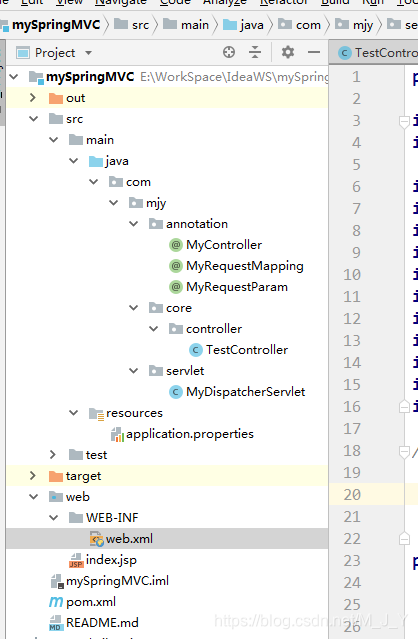项目结构

springmvc的工作流程?
一:在项目运行时会运行DispatchServlet类,主要干了四件事
1,加载配置文件
properties HashTable(scanPackage,com.mjy.core)
2,扫描用户设定包下的类,进行初始化
classNames : com.mjy.core.TestController
3,拿到扫描的类,利用反射进行初始化,并放到ioc容器中
ioc(testController,类实例对象)
4,初始化handlerMappimg将url与method对应上
handerMapping("test/test1",方法)
controllerMap("test/test1",类实例)
二:输入url进行访问时
1,先根据handermapping中的url将method取出来
2,获取方法中的参数列表
3,获取参数值
4,利用反射机制调用类中的方法
代码实现
1,三个注解
package com.mjy.annotation;
import java.lang.annotation.*;
/**
* @classDesc:
* @Author: mujuyan
* @createTime: 2019/3/15 10:55
*/
@Target(ElementType.TYPE)
@Retention(RetentionPolicy.RUNTIME)
@Documented
public @interface MyController {
/**
* 表示给controller注册别名
*/
String value() default "";
}
package com.mjy.annotation;
import javax.xml.bind.Element;
import java.lang.annotation.*;
/**
* @classDesc:
* @Author: mujuyan
* @createTime: 2019/3/15 10:57
*/
@Target({ElementType.TYPE,ElementType.METHOD})
@Retention(RetentionPolicy.RUNTIME)
@Documented
public @interface MyRequestMapping {
/**
* 表示访问该方法的url
*/
String value() default "";
}
package com.mjy.annotation;
import java.lang.annotation.*;
/**
* @classDesc:
* @Author: mujuyan
* @createTime: 2019/3/15 11:00
*/
@Target(ElementType.PARAMETER)
@Retention(RetentionPolicy.RUNTIME)
@Documented
public @interface MyRequestParam {
/**
* 表示参数的别名,必填
*/
String value();
}
2,TestController.class
package com.mjy.core.controller;
import com.mjy.annotation.MyController;
import com.mjy.annotation.MyRequestMapping;
import com.mjy.annotation.MyRequestParam;
import javax.servlet.http.HttpServletRequest;
import javax.servlet.http.HttpServletResponse;
import java.io.IOException;
/**
* @classDesc:
* @Author: mujuyan
* @createTime: 2019/3/15 11:02
*/
@MyController
@MyRequestMapping("/test")
public class TestController {
@MyRequestMapping("/test1")
public void test1(HttpServletRequest request, HttpServletResponse response, @MyRequestParam("param") String param){
try{
response.getWriter().write("this is "+param);
}catch (IOException e){
e.printStackTrace();
}
}
@MyRequestMapping("/test2")
public void test2(HttpServletRequest request,HttpServletResponse response){
try{
response.getWriter().println("test2...........");
}catch (IOException e){
e.printStackTrace();
}
}
}
3,MyDispatcher.class
package com.mjy.servlet;
import com.mjy.annotation.MyController;
import com.mjy.annotation.MyRequestMapping;
import javax.servlet.ServletConfig;
import javax.servlet.ServletException;
import javax.servlet.http.HttpServlet;
import javax.servlet.http.HttpServletRequest;
import javax.servlet.http.HttpServletResponse;
import java.io.File;
import java.io.IOException;
import java.io.InputStream;
import java.lang.reflect.Method;
import java.net.URL;
import java.util.*;
/**
* @classDesc:
* @Author: mujuyan
* @createTime: 2019/3/15 11:18
*/
public class MyDispatcherServlet extends HttpServlet {
private Properties properties = new Properties();
private List<String> classNames = new ArrayList<>();
private Map<String,Object> ioc = new HashMap<>();
private Map<String, Method> handlerMapping = new HashMap<>();
private Map<String,Object> controllerMap = new HashMap<>();
@Override
public void init(ServletConfig config) throws ServletException{
//1,加载配置文件
//properties hashtable(scanPackage,com.mjy.core)
doLoadConfig(config.getInitParameter("contextConfigLocation"));
//2,初始化所有相关联的类,扫描用户设定的包下面的类
//classNames : com.mjy.core.controller.TestController
doScanner(properties.getProperty("scanPackage"));
//3,拿到扫描的类,通过反射机制,实例化,并且放到IOC容器中(k-v beanName-bean) beanName默认是首字母小写
//ioc(testController,类实例对象)
doInstance();
//4,初始化HandlerMapping(将url和method对应上)
//handlerMapping("/test/test1",方法)
//controllerMap("/test/test1",类实例)
initHandlerMapping();
}
@Override
protected void doGet(HttpServletRequest request, HttpServletResponse response) throws ServletException, IOException {
this.doPost(request,response);
}
@Override
protected void doPost(HttpServletRequest request,HttpServletResponse response) throws ServletException,IOException{
try {
doDispath(request,response);
}catch (Exception e){
response.getWriter().write("500!");
}
}
private void doScanner(String packageName){
URL url = this.getClass().getClassLoader().getResource("/"+packageName.replaceAll("\\.","/"));
File dir = new File(url.getFile());
for(File file : dir.listFiles()){
if(file.isDirectory()){
//递归读取包
doScanner(packageName+"."+file.getName());
}else {
String className = packageName+"."+file.getName().replace(".class","");
classNames.add(className);
}
}
}
private void doDispath(HttpServletRequest request,HttpServletResponse response) throws Exception{
if(handlerMapping.isEmpty()){
return;
}
String url = request.getRequestURI();
String contextPath = request.getContextPath();
//拼接url并把多个/替换成一个
url = url.replace(contextPath,"").replaceAll("/+","/");
if(!this.handlerMapping.containsKey(url)){
response.getWriter().write("404 not found!");
return;
}
Method method = this.handlerMapping.get(url);
//获取方法的参数列表
Class<?>[] parameterTypes = method.getParameterTypes();
//获取请求的参数
Map<String,String[]> paramterMap = request.getParameterMap();
//保存参数值
Object[] paramVaules = new Object[parameterTypes.length];
//方法的参数列表
for(int i = 0; i < parameterTypes.length; i++){
//根据参数名称,做某些处理
String requestParam = parameterTypes[i].getSimpleName();
if(requestParam.equals("HttpServletRequest")){
//参数类型已明确,这边强转类型
paramVaules[i] = request;
continue;
}
if(requestParam.equals("HttpServletResponse")){
paramVaules[i] = response;
continue;
}
if(requestParam.equals("String")){
for(Map.Entry<String,String[]> param : paramterMap.entrySet()){
String value = Arrays.toString(param.getValue()).replaceAll("\\[|\\]","").replaceAll(",\\s",",");
paramVaules[i] = value;
}
}
}
//利用反射机制来调用
try{
method.invoke(this.controllerMap.get(url),paramVaules);
}catch (Exception e){
e.printStackTrace();
}
}
private void doLoadConfig(String location){
//把web.xml中的contextConfigLocation对应的value值的文件加载到流里面
InputStream resouceAsStream = this.getClass().getClassLoader().getResourceAsStream(location);
try{
//用properties文件加载文件里的内容
properties.load(resouceAsStream);
}catch (Exception e){
e.printStackTrace();
}finally {
//关流
if(null != resouceAsStream){
try{
resouceAsStream.close();
}catch (IOException e){
e.printStackTrace();
}
}
}
}
private void doInstance(){
if(classNames.isEmpty()){
return;
}
for (String className : classNames){
try {
//把类搞出来,反射实例化
Class<?> clazz = Class.forName(className);
if (clazz.isAnnotationPresent(MyController.class)){
ioc.put(toLowerFirstWord(clazz.getSimpleName()),clazz.newInstance());
}
}catch (Exception e){
e.printStackTrace();
continue;
}
}
}
/**
* 把字符串首字母小写
*/
private String toLowerFirstWord(String name){
char[] charArray = name.toCharArray();
charArray[0]+=32;
return String.valueOf(charArray);
}
private void initHandlerMapping(){
if(ioc.isEmpty()){
return;
}
try{
for(Map.Entry<String,Object> entry : ioc.entrySet()){
Class<? extends Object> clazz = entry.getValue().getClass();
if(!clazz.isAnnotationPresent(MyController.class)){
continue;
}
//拼接url时,是controller头的url拼上方法上的url
String baseUrl = "";
if(clazz.isAnnotationPresent(MyRequestMapping.class)){
MyRequestMapping annotation = clazz.getAnnotation(MyRequestMapping.class);
baseUrl = annotation.value();
}
Method[] methods = clazz.getMethods();
for(Method method : methods){
if(!method.isAnnotationPresent(MyRequestMapping.class)){
continue;
}
MyRequestMapping annotation = method.getAnnotation(MyRequestMapping.class);
String url = annotation.value();
url = (baseUrl+"/"+url).replaceAll("/+","/");
//这里应该放置实例和method
handlerMapping.put(url,method);
controllerMap.put(url,clazz.newInstance());
System.out.println(url+","+method);
}
}
}catch (Exception e){
e.printStackTrace();
}
}
}


























 被折叠的 条评论
为什么被折叠?
被折叠的 条评论
为什么被折叠?








